Chuanhong Liu
Lightweight Task-Oriented Semantic Communication Empowered by Large-Scale AI Models
Jun 16, 2025Abstract:Recent studies have focused on leveraging large-scale artificial intelligence (LAI) models to improve semantic representation and compression capabilities. However, the substantial computational demands of LAI models pose significant challenges for real-time communication scenarios. To address this, this paper proposes utilizing knowledge distillation (KD) techniques to extract and condense knowledge from LAI models, effectively reducing model complexity and computation latency. Nevertheless, the inherent complexity of LAI models leads to prolonged inference times during distillation, while their lack of channel awareness compromises the distillation performance. These limitations make standard KD methods unsuitable for task-oriented semantic communication scenarios. To address these issues, we propose a fast distillation method featuring a pre-stored compression mechanism that eliminates the need for repetitive inference, significantly improving efficiency. Furthermore, a channel adaptive module is incorporated to dynamically adjust the transmitted semantic information based on varying channel conditions, enhancing communication reliability and adaptability. In addition, an information bottleneck-based loss function is derived to guide the fast distillation process. Simulation results verify that the proposed scheme outperform baselines in term of task accuracy, model size, computation latency, and training data requirements.
OFDM-Based Digital Semantic Communication with Importance Awareness
Jan 04, 2024



Abstract:Semantic communication (SemCom) has received considerable attention for its ability to reduce data transmission size while maintaining task performance. However, existing works mainly focus on analog SemCom with simple channel models, which may limit its practical application. To reduce this gap, we propose an orthogonal frequency division multiplexing (OFDM)-based SemCom system that is compatible with existing digital communication infrastructures. In the considered system, the extracted semantics is quantized by scalar quantizers, transformed into OFDM signal, and then transmitted over the frequency-selective channel. Moreover, we propose a semantic importance measurement method to build the relationship between target task and semantic features. Based on semantic importance, we formulate a sub-carrier and bit allocation problem to maximize communication performance. However, the optimization objective function cannot be accurately characterized using a mathematical expression due to the neural network-based semantic codec. Given the complex nature of the problem, we first propose a low-complexity sub-carrier allocation method that assigns sub-carriers with better channel conditions to more critical semantics. Then, we propose a deep reinforcement learning-based bit allocation algorithm with dynamic action space. Simulation results demonstrate that the proposed system achieves 9.7% and 28.7% performance gains compared to analog SemCom and conventional bit-based communication systems, respectively.
Task-Oriented Explainable Semantic Communication Based on Semantic Triplets
Mar 22, 2023Abstract:Task-oriented semantic communication has garnered increasing attention due to its ability to reduce the amount of transmitted data without sacrificing task performance. While existing works have focused on designing advanced semantic communication architectures and efficient semantic codecs, challenges such as explainable and efficient semantic representation methods, and knowledge-based semantic compression algorithms have yet to be explored. These challenges have hindered the widespread adoption of semantic communication. To address these challenges, this paper proposes a novel Semantic Communication system based on Semantic Triplets (SCST), in which semantics are represented through explainable semantic triplets. A novel semantic extraction method is proposed to convert transmitted text into semantic triplets, where syntactic dependency analysis is introduced to improve semantic completeness. Furthermore, a semantic filtering method is designed to compress duplicate and task-irrelevant semantic triplets, making use of prior knowledge from the knowledge base. The filtered semantic triplets are then encoded and transmitted wirelessly to complete intelligent tasks at the receiver. To verify the effectiveness of the proposed SCST, it is applied to sentiment analysis and question-answering tasks, with semantic encoders and decoders designed for each task. Experimental results show that the proposed SCST achieves at least 43.5% and 52% accuracy gains, respectively, compared to traditional communication method. These results demonstrate that the proposed SCST can significantly improve semantic communication performance.
Deep Joint Source-Channel Coding for Wireless Image Transmission with Semantic Importance
Feb 05, 2023Abstract:The sixth-generation mobile communication system proposes the vision of smart interconnection of everything, which requires accomplishing communication tasks while ensuring the performance of intelligent tasks. A joint source-channel coding method based on semantic importance is proposed, which aims at preserving semantic information during wireless image transmission and thereby boosting the performance of intelligent tasks for images at the receiver. Specifically, we first propose semantic importance weight calculation method, which is based on the gradient of intelligent task's perception results with respect to the features. Then, we design the semantic loss function in the way of using semantic weights to weight the features. Finally, we train the deep joint source-channel coding network using the semantic loss function. Experiment results demonstrate that the proposed method achieves up to 57.7% and 9.1% improvement in terms of intelligent task's performance compared with the source-channel separation coding method and the deep sourcechannel joint coding method without considering semantics at the same compression rate and signal-to-noise ratio, respectively.
Deep Joint Source-Channel Coding Based on Semantics of Pixels
Aug 24, 2022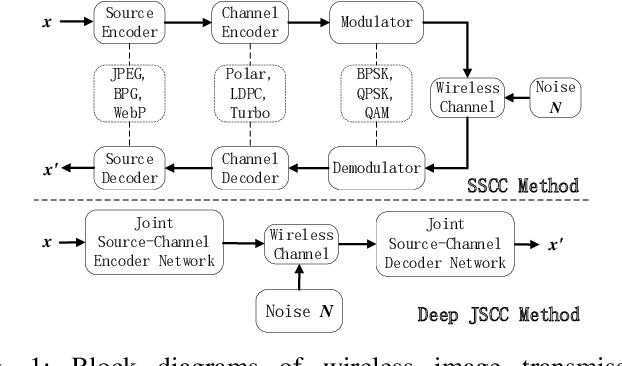

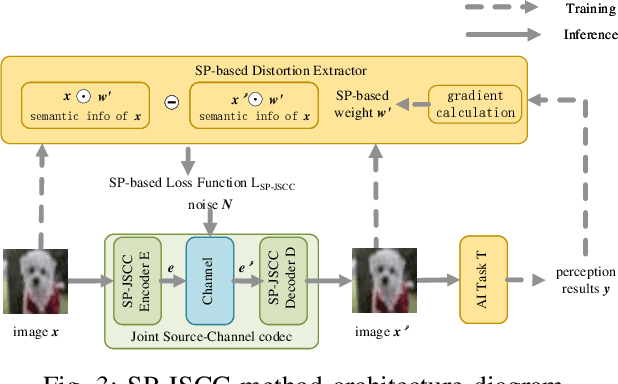

Abstract:The semantic information of the image for intelligent tasks is hidden behind the pixels, and slight changes in the pixels will affect the performance of intelligent tasks. In order to preserve semantic information behind pixels for intelligent tasks during wireless image transmission, we propose a joint source-channel coding method based on semantics of pixels, which can improve the performance of intelligent tasks for images at the receiver by retaining semantic information. Specifically, we first utilize gradients of intelligent task's perception results with respect to pixels to represent the semantic importance of pixels. Then, we extract the semantic distortion, and train the deep joint source-channel coding network with the goal of minimizing semantic distortion rather than pixel's distortion. Experiment results demonstrate that the proposed method improves the performance of the intelligent classification task by 1.38% and 66% compared with the SOTA deep joint source-channel coding method and the traditional separately source-channel coding method at the same transmission ra te and signal-to-noise ratio.
Adaptable Semantic Compression and Resource Allocation for Task-Oriented Communications
Apr 19, 2022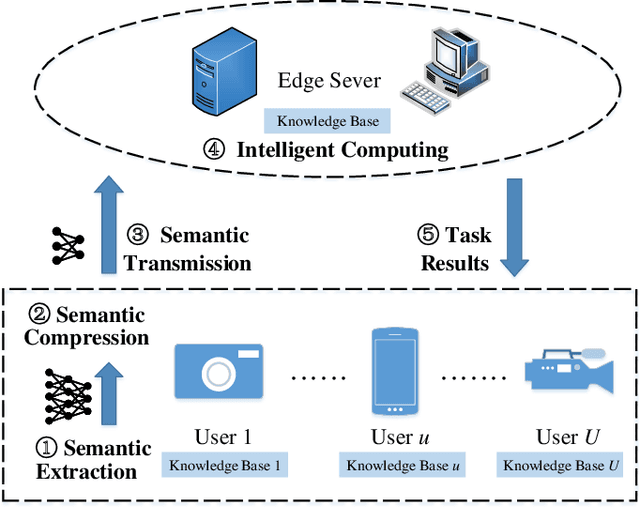
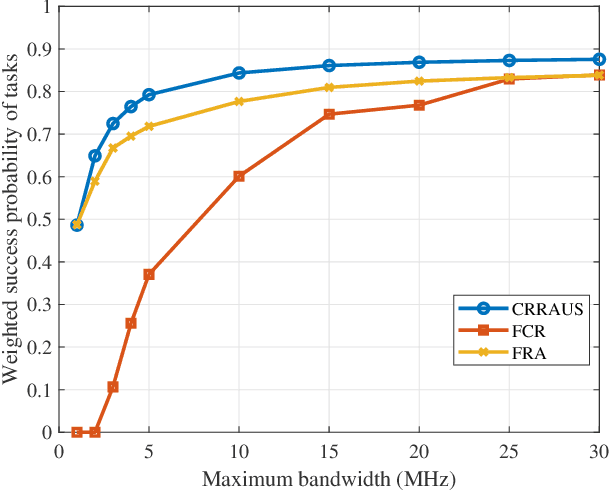
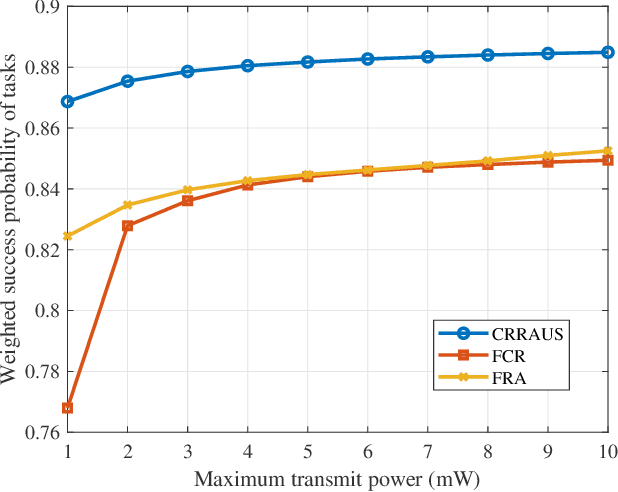

Abstract:Task-oriented communication is a new paradigm that aims at providing efficient connectivity for accomplishing intelligent tasks rather than the reception of every transmitted bit. In this paper, a deep learning-based task-oriented communication architecture is proposed where the user extracts, compresses and transmits semantics in an end-to-end (E2E) manner. Furthermore, an approach is proposed to compress the semantics according to their importance relevant to the task, namely, adaptable semantic compression (ASC). Assuming a delay-intolerant system, supporting multiple users indicates a problem that executing with the higher compression ratio requires fewer channel resources but leads to the distortion of semantics, while executing with the lower compression ratio requires more channel resources and thus may lead to a transmission failure due to delay constraint. To solve the problem, both compression ratio and resource allocation are optimized for the task-oriented communication system to maximize the success probability of tasks. Specifically, due to the nonconvexity of the problem, we propose a compression ratio and resource allocation (CRRA) algorithm by separating the problem into two subproblems and solving iteratively to obtain the convergent solution. Furthermore, considering the scenarios where users have various service levels, a compression ratio, resource allocation, and user selection (CRRAUS) algorithm is proposed to deal with the problem. In CRRAUS, users are adaptively selected to complete the corresponding intelligent tasks based on branch and bound method at the expense of higher algorithm complexity compared with CRRA. Simulation results show that the proposed CRRA and CRRAUS algorithms can obtain at least 15% and 10% success gains over baseline algorithms, respectively.
Bandwidth and Power Allocation for Task-Oriented SemanticCommunication
Jan 26, 2022Abstract:Deep learning enabled semantic communication has been studied to improve communication efficiency while guaranteeing intelligent task performance. Different from conventional communications systems, the resource allocation in semantic communications no longer just pursues the bit transmission rate, but focuses on how to better compress and transmit semantic to complete subsequent intelligent tasks. This paper aims to appropriately allocate the bandwidth and power for artificial intelligence (AI) task-oriented semantic communication and proposes a joint compressiom ratio and resource allocation (CRRA) algorithm. We first analyze the relationship between the AI task's performance and the semantic information. Then, to optimize the AI task's perfomance under resource constraints, a bandwidth and power allocation problem is formulated. The problem is first separated into two subproblems due to the non-convexity. The first subproblem is a compression ratio optimization problem with a given resource allocation scheme, which is solved by a enumeration algorithm. The second subproblem is to find the optimal resource allocation scheme, which is transformed into a convex problem by successive convex approximation method, and solved by a convex optimization method. The optimal semantic compression ratio and resource allocation scheme are obtained by iteratively solving these two subproblems. Simulation results show that the proposed algorithm can efficiently improve the AI task's performance by up to 30\% comprared with baselines.
Semantic Communications With AI Tasks
Sep 29, 2021
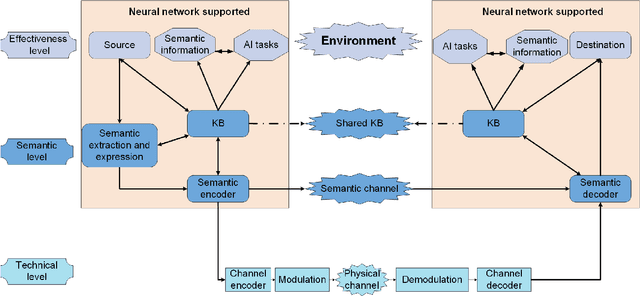
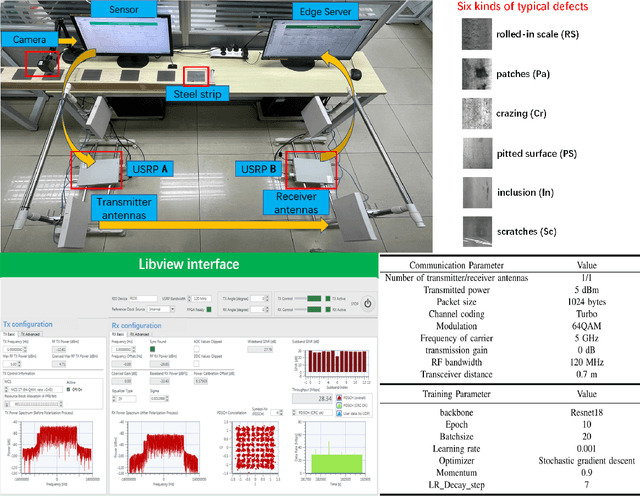
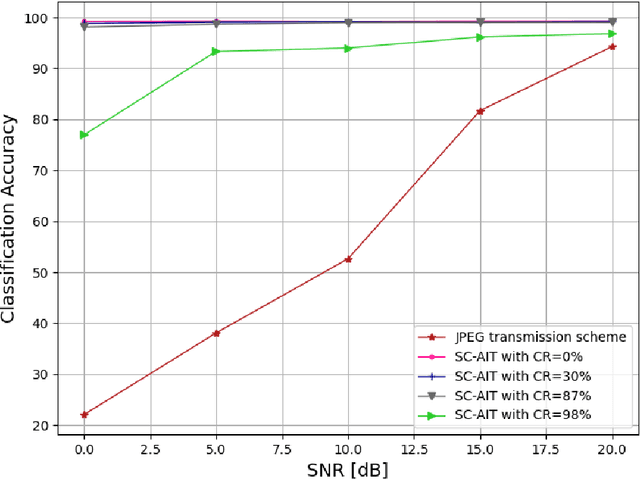
Abstract:A radical paradigm shift of wireless networks from ``connected things'' to ``connected intelligence'' undergoes, which coincides with the Shanno and Weaver's envisions: Communications will transform from the technical level to the semantic level. This article proposes a semantic communication method with artificial intelligence tasks (SC-AIT). First, the architecture of SC-AIT is elaborated. Then, based on the proposed architecture, we implement SC-AIT for a image classifications task. A prototype of SC-AIT is also established for surface defect detection, is conducted. Experimental results show that SC-AIT has much lower bandwidth requirements, and can achieve more than $40\%$ classification accuracy gains compared with the communications at the technical level. Future trends and key challenges for semantic communications are also identified.
Optimization of User Selection and Bandwidth Allocation for Federated Learning in VLC/RF Systems
Mar 05, 2021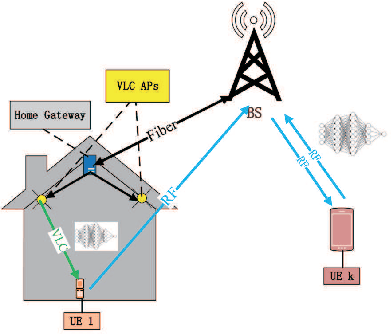
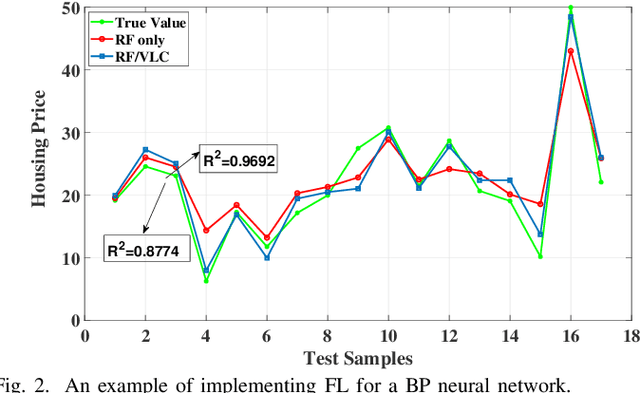
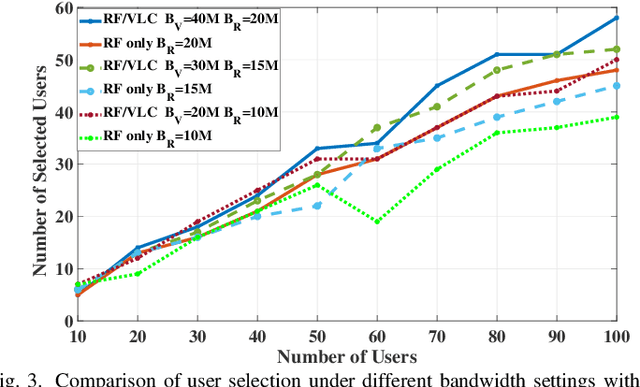
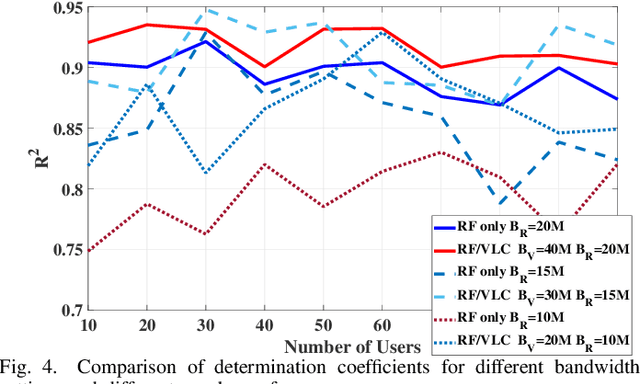
Abstract:Limited radio frequency (RF) resources restrict the number of users that can participate in federated learning (FL) thus affecting FL convergence speed and performance. In this paper, we first introduce visible light communication (VLC) as a supplement to RF in FL and build a hybrid VLC/RF communication system, in which each indoor user can use both VLC and RF to transmit its FL model parameters. Then, the problem of user selection and bandwidth allocation is studied for FL implemented over a hybrid VLC/RF system aiming to optimize the FL performance. The problem is first separated into two subproblems. The first subproblem is a user selection problem with a given bandwidth allocation, which is solved by a traversal algorithm. The second subproblem is a bandwidth allocation problem with a given user selection, which is solved by a numerical method. The final user selection and bandwidth allocation are obtained by iteratively solving these two subproblems. Simulation results show that the proposed FL algorithm that efficiently uses VLC and RF for FL model transmission can improve the prediction accuracy by up to 10% compared with a conventional FL system using only RF.
 Add to Chrome
Add to Chrome Add to Firefox
Add to Firefox Add to Edge
Add to Edge